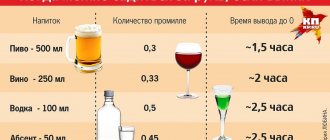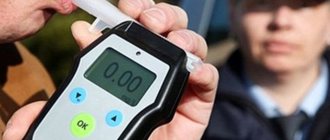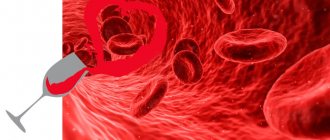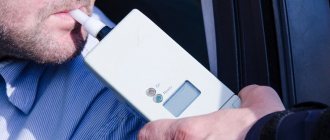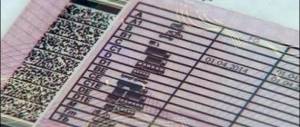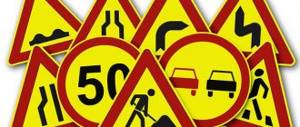Holidays are not uncommon in the life of the average person. They are accompanied by feasts with the consumption of alcoholic beverages. When the driver takes it on his chest, he is prohibited from driving the vehicle.
Dear readers! Our articles talk about typical ways to resolve legal issues, but each case is unique. If you want to find out how to solve your particular problem, please use the online consultant form on the right or call. It's fast and free!
A traffic police inspector can conduct a breathalyzer test; if the result in ppm is higher than the norm, you can expect penalties.
What is the permissible ppm rate in Russia?
The pan-European standard average is 0.5%. However, the norm varies in different countries from 0.00% to 0.8%. In many European countries, a glass of beer or a glass of wine is not a reason to give up driving.
In Russia, until 2013, the norm was absolute zero, now – 0.16% in exhaled air, 0.35% in the blood. This is due to the fact that the consumption of certain foods or medications can affect the results of an alcohol test.
Acceptable alcohol
- For 0.11 ppm is the permissible alcohol limit or not.
- Permissible dose of alcohol for an employee in hazardous work.
- Please tell me how many ppm are acceptable for alcohol?
- Is it acceptable to have alcohol in your blood and urine while driving?
- What dose of alcohol is acceptable at work?
- Permissible alcohol limit at work.
- ALLOWABLE limit of alcohol in the human body, not while driving?
If you find it difficult to formulate a question, call, a lawyer will help you: Free from mobile and landline Free multi-channel telephone If you find it difficult to formulate a question, call a free multi-channel telephone, a lawyer will help you 1.
Permissible alcohol limit at work. Lawyer Okulova I.V., 48539 answers, 25024 reviews, on the site since November 17, 2015 1.1.
There is no acceptable standard in production. Lawyer Khmelnitsky V.N., 3804 answers, 2307 reviews, on the site from 01/12/2018 1.2.
Dear Leonid Anatolyevich - less than 0.3 ppm of alcohol in the blood, or less than 0.16 ppm of alcohol in the exhaled air.
Lawyer Svalov A. A., 1447 answers, 523 reviews, on the site from 05/25/2016 1.3. Hello. If you are not a driver, then 0000 m/g.
2. Permissible dose of alcohol for an employee in hazardous work. Lawyer V.V. Kalashnikov, 188,349 replies, 61,525 reviews, on the site since September 20, 2013 2.1.
The employee does not have an acceptable dose of alcohol.
This is not driving a vehicle.
There are no such permissions here. Alcohol leads to dismissal () 3.
Is it acceptable to have alcohol in your blood and urine while driving? Lawyer Panfilov A.F., 50004 replies, 24582 reviews, on the site from 09/20/2013 3.1.
The use of substances that cause alcohol or drug intoxication, or psychotropic or other intoxicating substances is prohibited. Administrative liability provided for by this article and part 3 of article 12.27 of this Code occurs in the event of an established fact of consumption of alcohol-inducing substances.
What is ppm?
The degree of alcohol intoxication is measured in ppm. This value is indicated as a percentage. It is obtained by the formula: a gram of alcohol is divided by a liter of human blood.
If the test is based on an analysis of exhaled air, then the formula is slightly modified: milligrams of alcohol per liter of exhaled air.
Alcohol is not eliminated from the body for a long time, so even if you drank a couple of glasses of beer the night before, a breathalyzer in the morning may testify against you, although you will not feel intoxicated at all.
A glass of cognac takes the longest to eliminate (up to 30 hours), and the fastest is beer with a low alcohol content (300 g - within two to three hours).
How many ppm is in 1 glass of wine
The ppm level in the body after drinking a standard 100-milliliter glass of 11-proof wine depends on the gender and weight of the drinker.
For example, if a woman weighing 55 kilograms drinks a similar amount, then for her this figure will be slightly less than 0.29 ppm, on the verge of a ban on driving. And for a woman weighing 45 kilograms, the same volume will be expressed as 0.36 ppm.
A man who weighs 70 kilograms will receive a dose of 0.18 ppm from such a glass of wine, and with a weight of 90 kilograms this figure for him is 0.14 ppm.
Therefore, a 90-kilogram man can, in principle, drive a car even after two 100-milliliter servings of red wine.
Thus, you can only say how many ppm a glass of wine gives by knowing the person’s weight.
Photo: degrees of intoxication in different alcohols
What affects blood alcohol levels?
First of all, blood alcohol content is influenced by the amount of alcohol consumed. Along with this, this parameter is determined by a host of other factors.
Of significant importance is whether alcoholic drinks were combined without carbon and with gas. If you drink them together, the intoxication will be more pronounced than if you drink them separately.
If you drink drinks containing gas when it comes out of them, then in this case you will be able to reduce the amount of alcohol in your blood.
The speed of drinking alcohol is also important. As it enters the body, it is absorbed by it. And if you drink a certain amount of alcohol slowly over a certain period of time, the effect will be less than if you swallow the same amount in one gulp.
In this case, the body will not cope with the removal of ethanol, which will quickly enter the blood. On this basis, intoxication is more pronounced when drinking strong drinks; they are contained in smaller volumes and are often consumed faster.
Intoxication from vodka is stronger than from wine, and from wine stronger than from beer, even if the amount of ethanol itself is similar.
Blood alcohol content is determined by the amount of food eaten. When drinking alcohol without food, its concentration in the blood will be highest.
If, in parallel with drinking, you eat fatty foods, including meat and potatoes, then the alcohol content in your blood will be significantly lower.
Another determining factor is the state of the body itself. If a person has recently successfully lost weight, then, having lost 10 kilograms, he will feel an increased effect from the same dose of alcohol as before.
If the drinker is unwell, the alcohol content will be higher than in a completely healthy state. The usual lack of sleep also leads to an increase in its effect.
When flying across multiple time zones, a person is more susceptible to the influence of alcohol.
Obviously, at the same dose, a woman will have more alcohol in her blood, since the metabolism of the two sexes is somewhat different.
Another significant factor is age; at 20 years old, alcohol is processed much better than two years later.
Endogenous alcohol is present in the human body, its concentration varies; if a person has a relatively high concentration, then it can give a deviation not in his favor when measuring alcohol levels.
Finally, nationality also plays a role; representatives of some nations tolerate alcohol worse.
Factors affecting the yield of alcohol
Alcohol entering the bloodstream begins to partially leave the body immediately afterward through other fluids into which it enters from the blood. Ethanol comes out with sweat, saliva and when going to the toilet.
Among the factors that determine the release of alcohol from the body is the state of a person’s health.
In particular, the level of performance of his liver and kidneys is important, since these organs are responsible for processing ethanol.
The condition of these organs has a greater influence on the rate of alcohol release than his gender and age.
Indicators of lung function also play a role, since a certain part of ethyl alcohol leaves with exhalation, so a more powerful exhalation means a faster process.
At the same time, a person’s gender still affects the yield of alcohol. In men, this process occurs faster due to differences in female physiology.
On average, the male body gets rid of 0.15 ppm per hour, and the female body - from 0.1 ppm. In emergency cases, when a person has drunk a lot, the body mobilizes and the exit rate increases to 0.26 ppm per hour.
The quality of the drink also matters. If it was produced through natural fermentation, it will leave the body faster.
At the same time, harmful impurities lead to a delay in the elimination of alcohol, and the same applies to by-products.
So, due to the presence of tannins in cognac, ethanol is eliminated when drinking this drink longer than when drinking vodka, which is comparable in strength.
How to calculate the ppm of alcohol in the blood, see the article: how to count ppm. If you are interested in the question of how to reduce ppm in exhaled air, read here.
What matters is how consistently a person drinks alcohol. If this happens regularly, it will take longer for ethanol to leave the body.
Another factor is emotional state. If a person is deeply affected by something or is experiencing depression, then the alcohol will go away faster. Finally, colder temperatures will comparatively speed up the removal of ethanol.
Video: how long does it take for alcohol to disappear from the body?
How long after you can drive after drinking a bottle of red drink (hours)
A standard bottle of red wine holds 0.75 liters of drink, its strength can be 9-16 degrees.
If a bottle of wine with a strength of 11 degrees is drunk by a woman weighing 60 kilograms or more, the alcohol content in her blood will reach 2 ppm.
As a result, if her weight is 55 kilograms, then she will be able to drive in 16 hours. As a woman loses weight, the amount of time she will need to wait will increase. At the same time, women weighing 70 kilograms will be able to drive a car in 12 hours.
A man of the same weight, having consumed the same three-quarter liter bottle with an alcohol content of 11 degrees, will gain the right to drive after 10 hours.
And a 100-kilogram man who drank this amount of red wine will receive less than ppm, and he will be able to drive a vehicle in just 7 hours.
How to measure the amount of alcohol in the blood?
Alcohol levels can be measured using blood, urine, saliva and breath tests. There are several devices through which the degree of intoxication is checked:
- Test strip. There is an indicator at the tip of the strip proposed for research. It is placed in a person's saliva. Depending on how much the careless driver drinks, the indicator will change color, from lighter to brighter. However, the main disadvantage of this method is that it cannot accurately say how many ppm the norm is exceeded.
- Tubes Inside the disposable device there is a special substance that reacts to alcohol, acetone. A tube is inserted into the device and you should exhale into it after taking a deep breath. The yellow indicator changes to green when intoxicated. Depending on the level of ethylene alcohol in the blood, the shade of green may change from light to dark.
- Breathalyzer. The most popular method of testing for intoxication from alcoholic beverages. Devices of this type are divided into several types: one is used only in the laboratory, since it gives out the ppm amount after a long time, the other reacts not only to alcohol, so the result is not as accurate as we would like, and the third is used everywhere, since it quickly determines the content alcohol in the blood.
How to avoid a fine
Alcoholic drinks
The period of weathering of alcohol from the body is quite long.
Some averages:
| Name | Fortress | Time | Drink volume | Human weight |
| Beer | 4-6o | 30-40 min | 100 g | 80 kg |
| Champagne | 11o | 1 hour 15 minutes | ||
| Vodka | 40o | 4 hours 20 minutes | ||
| Cognac | 42o | 4 hours 40 minutes |
Just feeling that a person has already sobered up is not enough. The test may not be in his favor.
Products
As already mentioned, alcohol is produced in the blood even without drinking alcohol-containing liquids.
The most “dangerous” products include:
- all fermented milk;
- kvass;
- lemonade;
- beer without alcohol content;
- oranges;
- overripe bananas;
- juices (warm);
- chocolate;
- sausages;
- black bread.
But a high concentration of alcohol can be detected only with a large amount of consumption. If one sausage sandwich and candy are eaten, this will be taken into account precisely because of the introduction of a discount for the error. Until 2013, you could get a fine by drinking a glass of yogurt.
Medicines that increase ppm
Before using the medicine, you should carefully read the instructions to see if taking the medicine and driving a car are compatible.
These popular medications contain alcohol, so they can increase its levels in the blood:
- Medical alcohol.
- Antiseptics.
- Iodine and solutions containing this substance.
- Novocaine.
- Levomycetin.
- Pihtanol.
- Inhalipt.
- Rhinital.
- Gutron.
- Aflubin.
- Valocardine.
- Syrups based on tinctures of medicinal plants.
- Tinctures of medicinal herbs.
- Corvalol.
- Valerian.
Permissible alcohol limit while driving
What is the legal blood alcohol limit? This is when alcohol seems to be present after an appropriate medical examination for intoxication, and at the same time no punishment is provided for this. How can this be? First, we need to remind you that the degree of alcohol in the blood is measured in ppm. Permille is one thousandth of a substance, in other words a tenth of a percent. Thus, 1 ppm when measuring the degree of intoxication means that the level of alcohol is 1 milliliter for every liter of blood . It is worth immediately noting that a level of 5 ppm is considered fatal for most people, and a critical level is 3 ppm or more. So how many ppm is allowed in Ukraine?
If police officers have established that the driver of a car is intoxicated, they draw up a report with the wording “driving a vehicle by a person under the influence of alcohol.” This formulation is provided for in Article 130 of the Code of Ukraine on Administrative Offences. At the same time, neither in this article, nor in other articles of this code, there are any indications of what exactly is considered a state of intoxication. Previously, it was believed that drunk driving was any reading from a special gas analyzer (Drager) that differed from zero. The scheme is simple: zero means sober, more than zero means drunk. But since 2021, changes have occurred, and any driver is considered sober if the dragger shows no more than 0.2 ppm . The norm is written in a special Instruction for police officers, which determines the procedure for identifying signs of alcohol intoxication in drivers. At the same time, one cannot discount such a factor as the influence of certain diseases on the readings of the device. Thus, people with diabetes are at risk. In addition, drinking such a seemingly harmless drink as kvass or kefir can also cause readings other than zero to appear on the breathalyzer. Therefore, the permissible limit of 0.2 ppm is better regarded as an adjustment for the error of the device, and not as an opportunity to drink a little while driving a car.
Use the consultation:
How to drink alcohol correctly as a driver?
The driver will not have to completely eliminate alcohol from his life, despite the fact that it takes a long time to be eliminated from the body.
You need to observe moderation in everything, but if there is a party with alcoholic drinks planned for the evening, you should take care in advance about what transport you will use to go home and where you will leave your car.
The weathering of alcohol depends on many factors.
These include:
- Human weight.
- Metabolism.
- Floor.
- Age.
- Volume of products consumed.
- Brand and percentage of alcohol in the drink.
It is important to remember that it is not always possible to get behind the wheel in the morning after a stormy feast. Just one can of beer is eliminated after 6 hours. And strong drinks (whisky, cognac, vodka) - more than a day. In order not to run into a fine and deprivation of your driver's license, you need to think in advance whether it is worth drinking.
How long does it take for half a liter of wine/vodka/beer to dissipate, and how to speed up the process?
After you have consumed a sufficient amount of alcohol and before you want to get behind the wheel - remember! Neither folk remedies nor various medications will help to instantly speed up the process of eliminating alcoholic beverages.
They are only:
- Relieves symptoms of intoxication.
- Will help remove the smell of fumes.
- They will bring you into an understanding state.
- They will remove the headache.
- Will promote awakening.
Therefore, it will not be possible to speed up the process much. Full recovery after a good time with alcoholic drinks will take at least 24 hours.
Methods of punishment for exceeding the ppm norm
Penalties for drunk driving have been introduced in Russia:
- If a drunk driver is caught for the first time, he must pay a fine of 30 thousand rubles, and his license will be deprived for up to two years.
- Driving while intoxicated a second time - a fine of 50 thousand rubles, deprivation of rights for almost three years.
- In case of repeated violations, the offender faces imprisonment of up to 15 days.
Even if the driver refuses to take the test, he pays a minimum fine (30 rubles) and is deprived of his license for 2 years.
Important! If the driver was not the owner of the car, but a drunk person to whom the vehicle was simply handed over, the owner will be fined and will also be deprived of his driver’s license.
Is it possible to have a glass of wine while driving, and what are the consequences of such a whim?
The consequences of your actions can go in three ways:
- You will be met by patrol police. They can search the car, ask for a driver's license, or get a breathalyzer at any time. If the ppm level exceeds 1.6, you will be fined; in case of severe intoxication, your license will be withdrawn for 1 year. The driver may refuse to take the test using the device, then this will indicate that he was caught driving under the influence by refusing to be tested. This will greatly aggravate the situation of returning rights.
- You will drive home calmly and slowly. Such actions are most not recommended! But, nevertheless, they are committed often and with impunity. Before you get behind the wheel, be aware of your actions. And don't act so irresponsibly.
- There will be a traffic accident. It could be anything: a minor accident, a serious injury accident, a fatal accident, or the killing of pedestrians. So, most often, with particularly drunk people. Then not only their rights are taken away, but they are also sent to prison for considerable periods.
We hope that no one path will be chosen by you or your friends after having fun. Drivers are people who are responsible for other lives. Remember this when you get your license, when you want to drive if you are not in the best condition. Take care of yourself, your loved ones and be responsible for your actions.
Add AN to your sources so as not to miss important events - Yandex News
- Northern Fleet ships seriously frightened the crew of the aircraft carrier Queen Elizabeth
- Political scientist Sergei Markov: “Lukashenko simply shocked the world”
- Construction of Nord Stream 2 is already underway in German territorial waters under the protection of 4 ships
- The ocean has figured out how to deal with plastic waste, how can this end for humans?
- Latvian MP: EU got hit in the face
Become a member of the CLAN and every Tuesday you will receive the latest issue of “Arguments of the Week” with a discount of more than 70%, along with exclusive materials not included in the newspaper. Get premium access to a library of the most interesting and popular books, as well as an archive of more than 700 published issues for FREE. In addition, you will have the opportunity to benefit from free legal advice from our experts for a whole year.
- Enter your email address, then select any convenient payment method for your annual subscription
- Scan the QR. In the Sberbank Online application that opens, enter the annual subscription cost (490 rubles). Then send the confirmation code by email
Or
How to behave if tested for alcohol intoxication?
As you know, traffic police inspectors are divided into conscientious and not so conscientious, who want to earn more money by reaching an agreement on the spot with the offender.
What you need to pay attention to in order for the inspection to pass according to the standard:
- The employee must draw up a protocol indicating the date, place and other nuances. When the document is drawn up, two witnesses are already present.
- Before the test, the driver must be notified of exactly how the procedure is carried out and clearly shown where to blow and with what force. In this case, the device must have an intact seal. Be sure to check the passport for the technical device.
- During the procedure for taking an alcohol test, there must be witnesses nearby. The device is initially turned off.
- The device must be unpacked in front of the driver, and a new tube is inserted. There are cases where alcohol was injected into the mouthpiece.
- The first test can be repeated, if the result is not satisfactory, you doubt that everything went in an honest manner.
- You need to breathe until you hear a beep.
- Check the result, printed in triplicate, with the readings of the technical device.
- The verification process can be repeated after a quarter of an hour, if the driver is forced to go through immediately - this is a violation of the law, because the second result will be considered the correct result.
- You don’t have to accept the results of the breathalyzer, but undergo a medical test at an institution where you will go immediately with a traffic police inspector and the same witnesses.
- If a sober driver is incorrectly accused of being under the influence of alcohol, recordings from a DVR or voice recorder can be presented in court. In addition, the medical test, which is considered the most accurate, may also raise doubts about the correct procedure. In this case, you can get checked within a few hours at any medical center with a license and the necessary technical equipment.
Promille is a value that measures the amount of alcohol in a person’s blood or exhaled air. In Russia, you cannot drive if the ppm level exceeds 0.16%.
It is important to remember that alcohol is not eliminated from the body immediately, but over the course of a day (sometimes longer); the result is also affected by the use of medications and food. For violations of the law, you can expect deprivation of your driver's license and large fines.
To avoid becoming a victim of a traffic police inspector, be calm during the inspection, do not agree to solve the problem on the spot, pay attention to all the details of the procedure.
Didn't find the answer to your question? Find out how to solve exactly your problem - call right now: +7 (Moscow) +7 (812) 309-53-42 (St. Petersburg) It's fast and free!
Free online consultation with a car lawyer
Didn't find the answer to your question? Find out how to solve exactly your problem - call right now: +7 (Moscow) +7 (812) 309-53-42 (St. Petersburg) It's fast and free!
How long does it take for alcohol to leave the body?
Very often, the courts consider issues of deprivation of the rights of a person who drank the day before and got behind the wheel in the morning. This is a really big problem that not everyone thinks about. Strong alcohol is excreted from the body depending on the amount drunk. The elimination period can be about 12-15 hours. For example, 300 ml of cognac will be excreted in 22 hours with a body weight of 80 kg. During this period, it is better to avoid driving.
It is worth remembering these features:
- It is better not to drive a car for 24 hours after drinking alcohol, especially if you drank more than 200-250 ml of strong alcohol, it takes a long time to eliminate;
- the very fact that you slept for 5-7 hours does not mean that all alcohol has already been removed from the body; sleep does not speed up this process and does not increase the amount of alcohol removed from the blood;
- most fines are issued precisely after the holidays in the morning, when drivers do not understand that they are actually breaking the law and driving in a state of mild intoxication, running into deprivation;
- the lower your body weight, the longer it will take for every hundredth of a ppm to be excreted, so it’s worth taking into account the amount of alcoholic beverages you drink if you have to travel in the near future;
- Even the weakest alcoholic drinks with a minimum concentration of alcohol take a long time to be removed and can become a reason for deprivation of a license and other sanctions.
There is an opinion that in Russia you are not fined for a glass of wine. In fact, 200 ml of wine will be eliminated from the body of a healthy man in about 5 hours. A woman risks extending this period to 7-8 hours. So a glass of wine at a corporate party can cause big trouble with your driver's license. It is much cheaper and easier not to drink or not to drive in this state at all, without calculating how many ppm you can have without punishment.
What are the dangers of frequent alcohol consumption?
Any alcoholic beverages are poison. Even if you add vitamins and dilute it with grape juice, the drink will still be poisonous. A small dose produces consequences that are invisible to the naked eye; valuable vitamins and minerals are destroyed and the beneficial microflora of the stomach dies. A large dose causes nausea, vomiting, dizziness, headache and hangover.
Drinking alcohol is dangerous not only by developing addiction. If going without wine or beer for several days, a week or a month is a feat, then it’s worth thinking about. Have beer, wine or cognac become such a strong part of life? Is everything else not as enjoyable as it used to be? Not enough pleasant emotions in life without alcohol?
If a person is waiting for a glass of wine in the evening, and during the day he looks forward to it, this is addiction. If, without wine or beer, you suffer from a bad mood and irritability, and even the very idea of alcohol inspires and makes you happy, these are the first signs of addiction. If you can’t go a day without beer or wine, you should ask for help.
Women are more susceptible to addiction - those on whose shoulders lies the future of the family, children and humanity.
Factors affecting the rate of alcohol weathering
So, the main factors on which the rate of alcohol weathering directly depends:
- Weather conditions: the higher the ambient temperature, the faster the body clears alcohol from the blood, removing it through sweat.
- Degree of fullness of the stomach: if you drink alcohol on an empty stomach, it will take much longer to remove alcohol from the blood than if you drink alcohol with meals or on a full stomach.
- Pastime after drinking alcohol: if you want to quickly remove alcohol from your blood, try to do as much physical activity as possible - again, alcohol is eliminated faster through sweat than if you decide to just lie down and rest.
- The peculiarities of the female body that apply to the rate of weathering of alcoholic beverages are that for women, compared to men, the time increases by an average of 1 hour for every 100 milliliters drunk.
- Age – older people and teenagers become intoxicated faster and take longer to recover from it.
- State of health - a strong healthy person quickly gets rid of alcohol in his blood.
- Use of medications.
Time to remove alcohol from the blood
As we have already established, one ppm corresponds to one milliliter of alcohol in one liter of blood. Thus, with the same amount of alcohol consumed, the person who has more blood in the body will have a lower value. That is, the greater the mass, the less alcohol in the blood. Below is a calculation table, the so-called alcohol calculator, based on which you can determine how much time must pass after drinking alcohol before you can drive.
| Amount drunk, ml | Human weight, kg | ||||
| 60 | 70 | 80 | 90 | 100 | |
| beer 4%…5% | |||||
| 500 | 3 hours | 2.5 hours | 2 hours | 2 hours | 1,5 hour |
| 1000 | 6 hours | 5 o'clock | 4.5 hours | 4 hours | 3.5 hours |
| 1500 | 9 o'clock | 7.5 hours | 6.5 hours | 6 hours | 5 o'clock |
| champagne 9%…11% | |||||
| 100 | 1,5 hour | 1,5 hour | 1 hour | 1 hour | 1 hour |
| 300 | 5 o'clock | 4 hours | 3.5 hours | 3 hours | 3 hours |
| 500 | 8 ocloc'k | 7 o'clock | 6 hours | 5 o'clock | 5 o'clock |
| dry, semi-dry wine 11%…14% | |||||
| 100 | 2 hours | 2 hours | 1,5 hour | 1,5 hour | 1 hour |
| 500 | 10 hours | 9 o'clock | 8 ocloc'k | 7 o'clock | 6.5 hours |
| 700 | 14 hours | 12 hours | 11 o'clock | 10 hours | 9 o'clock |
| tincture, liqueur 25%…30% | |||||
| 100 | 4 hours | 3.5 hours | 3 hours | 2.5 hours | 2 hours |
| 250 | 10 hours | 8 ocloc'k | 7 o'clock | 6 hours | 5 o'clock |
| 500 | 20 hours | 17:00 | 15 hours | 13 hours | 11 o'clock |
| vodka 40% | |||||
| 100 | 6 hours | 5 o'clock | 4.5 hours | 4 hours | 3.5 hours |
| 250 | 14 hours | 12 hours | 11 o'clock | 10 hours | 9 o'clock |
| 500 | 29 hours | 25 hours | 22 hours | 19:00 | 17:00 |
| whiskey, cognac 42%...43% | |||||
| 100 | 6 hours | 5.5 hours | 5 o'clock | 4.5 hours | 4 hours |
| 250 | 15 hours | 13 hours | 11 o'clock | 10 hours | 9 o'clock |
| 500 | 31hours | 26 hours | 23:00 | 21 o'clock | 18 hours |
But we must not forget that the calculation of alcohol in this table to determine the permissible dose of alcohol while driving is very arbitrary and depends on many factors.
Use the consultation: Are you sure that the permissible level of alcohol for water is 0.2 ppm?
